Pillars of Eternity (PC) Review
By Jordan Hurst  11.04.2015
11.04.2015
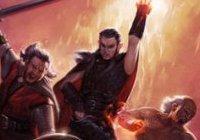
When a developer lists the titles that inspired its new game in the opening sentence of its official description, it's usually a pretty big red flag. Not only does it draw immediate comparisons to other, more venerable games, it usually indicates that the new one hasn't included any original thought of its own. As such, Pillars of Eternity raised immense suspicion and anticipation by announcing its intentions to recapture the spirit of the Infinity Engine titles: the seminal Baldur's Gate series, the cult classic Planescape: Torment, and the generally good but kind of forgettable Icewind Dale titles. Of course, if anyone is qualified to walk in those games' footsteps, it's Obsidian, which, for all intents and purposes, is Black Isle Studios, the company behind three of the five Infinity Engine releases. Obsidian has been cranking out fascinating (albeit often flawed) RPGs for a decade now, and with Pillars of Eternity, it has not only recaptured the spirit of its heritage, it has sharpened it into something fresh and modern. This is the adventure that fans have been waiting for since Baldur's Gate III was cancelled.
The first thing that marks Pillars of Eternity as more than just nostalgia is how imaginative it turns out to be. Those who enjoy original experiences can usually safely ignore high fantasy RPGs, but this one offers more than enough twists and additions to the formula to make things interesting, even for genre veterans. Novelties appear as early as character creation, where original races like the titanic, amphibian Aumaua and otherworldly Godlike supplement the usual trinity of humans, elves, and dwarves. Furthermore, many traditional character classes have been overhauled with unique mechanics: priest abilities become stronger the more they adhere to the preferred dispositions of their chosen god, rangers are always paired with a melee-focused animal companion, and bards (now chanters) accumulate "phrases" to power offensive spells in addition to their usual support roles. During gameplay, many of the game's irregularities stem from its combat systems. However, it only deviates from RPG norms in order to make combat more balanced and engaging; it never tries to be different just for the sake of being different.
Most notably, accuracy and evasion (which is separated into four different stats targeted by different attack types) have superseded attack and defence as the most important factors in damage-dealing. Using these values, attack rolls are resolved into the standard misses, hits, and critical hits, but also grazes, which diminish attacks without nullifying them completely. Crucially, this system governs all combat actions, including debuffs, for which grazes and critical hits adjust the duration and potency of their effects. Traditional defence is now "damage reduction," which lowers damage incurred, either overall or against specific damage types (in other words, fire or slash). Damage reduction is entirely dependent on armour, however, and usually comes with a speed trade-off, so raising it is not necessarily desirable. On the other hand, players and enemies with high specific damage reduction or evasion can be practically invincible against those types of assault, necessitating constant awareness and tactical changes. Fortunately, characters can carry multiple weapon sets into battle, ensuring that between their six simultaneous party members, smart players can be prepared for any challenge.
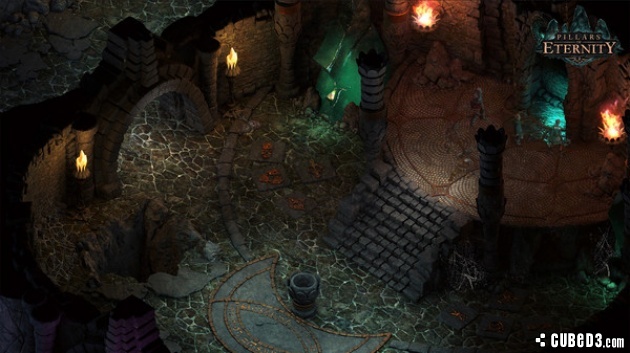
Smart play is necessary to succeed because Pillars of Eternity can be very unforgiving at times. It's not unfair (the only part of it that feels cheap is how long it takes to grasp the intricacies of the combat), it's just intense. The outcome of Obsidian's tweaks to standard RPG mechanics is an enthralling game where players must use every ability at their disposal to survive, including adjusting for enemy weaknesses, crafting and enchanting items, and utilising support classes as much as possible. Additionally, party members have the usual "hit points" divided into endurance and health categories. Both are drained by damage, but at different rates. When endurance is depleted, the character becomes incapacitated, but all endurance is regenerated at the end of a battle. This has the spectacular effect of giving each battle a significance and challenge usually reserved for bosses, and completely eliminating the element of attrition and filler often associated with long RPGs. However, merely scraping by in combat still has long-term consequences in the form of health loss, which is more difficult to recover and, if drained completely, can kill a character permanently.
The possibility of permanent character death is balanced by the player's ability to recruit custom-made characters to either supplement or replace those introduced during the story. This is also a worthwhile feature in its own right, allowing the game to be as open-ended as the user desires, although the expendable nature of the main companions prevents them from having much impact on the plot, and their reasons for joining the protagonist are rather tenuous. Pillars of Eternity's structure as a whole is actually somewhat unorthodox. Experience is only gained from completing quests and discovering new locations, and never from battle. While this does lead to some odd level design choices wherein paths that only end in combat are ultimately pointless, it also purges grinding from the gameplay entirely. There's also no sprawling, barren overworld to explore, keeping the focus on the gameplay and away from the Elder Scrolls envy that's clogging the modern Western RPG. The player is even given an upgradeable stronghold to govern in a massive, rewarding side-quest that expands on a similar feature from Neverwinter Nights 2.
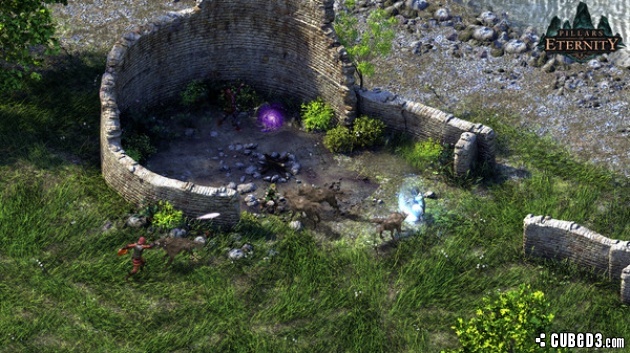
One of the most enticing promises made by Obsidian was that Pillars of Eternity would evoke the maturity and nuance of Planescape: Torment. Once again, if any other developer had claimed this, it would have sounded preposterous, but in the hands of the scribes behind Knights of the Old Republic II and Fallout: New Vegas, the world of Eora becomes a believable, intricate, and subtly ominous creation. This is a genuinely mature work of dark fantasy - not the eye-roll-inducing marketing label of Dragon Age, where "dark" means "battles end with the party covered in blood." Prejudice and superstition inform much of the plot and characterisation, player decisions are categorised by the disposition they lean toward, rather than good or evil, and almost every objective features a mid-quest subversion that forces player to reassess the morality of the situation. Additionally, the dialogue is as sharp and (at times) darkly humorous as Infinity Engine fans could hope for. The biggest flaw with the writing is that the player's companions aren't particularly memorable - they are usually most notable for what they are, rather than who.
The setting, on the other hand, is remarkable. The game's world is undergoing a fantasy analogue of the Renaissance, having recently emerged from a medieval stasis. More importantly, religion is a driving force in the game's events, rather than a passing justification for eccentric behaviour. This is because, in Eora, souls are a quantifiable substance, and gods and reincarnation are demonstrably real. They are, however, poorly understood, so when an epidemic of children born without souls covers an entire nation, massive turmoil erupts. Those affected begin to blame soul-based sciences and worshippers of related gods, whose concern for the world is questionable at best. The protagonist enters this conflict when they witness a foreboding ritual that seemingly awakens them to memories of a past life and grants them the power of a Watcher - a being that can see unguarded souls and tap them for insights into their history. From there, the player follows the trail of the man leading the ritual (who turns out to be a spectacularly menacing villain) in an attempt to learn why they have this power and how it ties in to the scourge that's choking the country.
If there's anything holding this narrative back, it's the game's obvious lack of budget. $4 million is, of course, staggering by Kickstarter standards, but for an enormous modern RPG, it's a pittance. As a result, all but the most important actions are merely described with text instead of enacted, defeating the purpose of a visual storytelling medium like videogames. It's not a terrible circumstance (the prose is beautifully written), but it is rather discordant when the reader is explicitly told that a character is pacing the room while their body is visibly still. Then there are the backer narratives - Lost Odyssey-esque bite-sized stories designed by Kickstarter donators that can be discovered by peering into the souls of unique NPCs. They are full of vivid imagery and flowing vocabulary, but they have no real purpose. They never connect to the plot or setting in any meaningful way, they are not particularly entertaining, and they are far too short to elicit a strong emotional reaction.
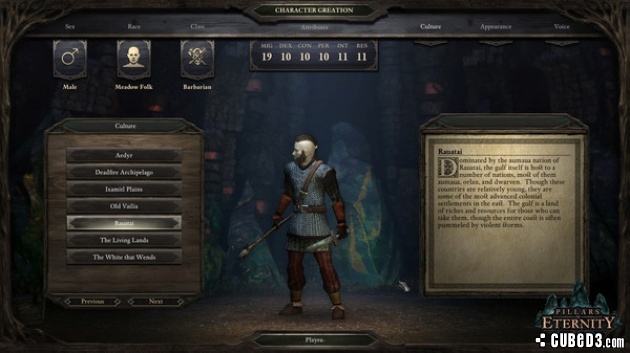
Budget shortcomings are evident in the production values, too, particularly in the character models, which, when zoomed in, display prominent visual artefacts and minimal detail. Furthermore, the mostly respectable voice acting is tarnished by its tendency to drop in and out within a single conversation (as opposed to the usual RPG practice of dividing dialogue into major and minor scenes and applying voice acting only to the former), as well as the small handful of repeated battle quotes. On the other hand, the soundtrack is sublime. Although it takes its instrumental cues from the epic orchestras of AAA titles, it takes a more minimalist approach to song writing. This restraint is perfect for capturing the beauty, solemnity, and horror that the setting deserves. Finally, although the area maps appear oddly static, they are still gorgeously drawn, and their isometric perspective rarely gets in the way of events.
Funding aside, what Pillars of Eternity lacks in technical ability, it makes up for with excellent game design. The game includes numerous features that deserve to become standard in future RPGs. For starters, the three main difficulty settings adjust the number and type of enemies encountered, rather than just lazily pumping up their stats. The game also contains several alternative difficulty settings that can be activated in conjunction with the main slider, providing unorthodox challenges like limited save slots or disabled player assistance features. Next, since combat is of the "real-time with pause" variety, players are given detailed control over what events will cause the game to pause automatically. The game also alleviates the tedium that comes with a limited inventory without removing the related layer of challenge by dividing items into quick slots (to be used in battle), character inventories (for equipment and excess battle items), and the stash (an infinite repository that can only be accessed at safe areas). Finally, the "double speed" button is greatly appreciated, especially while sneaking through trap-filled dungeons at a slowed pace.
Of course, it wouldn't be an Infinity Engine throwback without some interface issues. Pathfinding in particular, it seems, has not improved with age, so melee fighters occasionally have trouble finding obvious gaps in a brawl through which they can attack. Combat gets messy very quickly in Pillars of Eternity. Between the six controllable characters, overwhelming statistic management, and omnipresent flurry of particle effects, it's very easy to lose track of what needs to be targeted and by whom. Fortunately, most of the complications have a strategic element to them - area of effect spells are often capable of friendly fire, and the limited angles enemies can be engaged from forces teams to balance ranged and melee weapons for efficiency. As a result, making sense of the carnage at least feels like it's part of the game's intended challenge. Also, the controls are definitely not a problem; the RTS-style commands are accurate and responsive, and the ability to queue actions by holding Shift is a godsend.
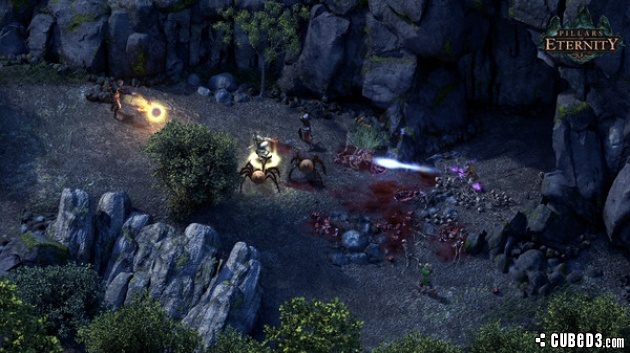
Cubed3 Rating
Great - Silver Award

Pillars of Eternity is a rare game that delivers exactly what it promises, all of which are things that gamers frequently ask for: legitimately mature narrative, deep tactical combat, and a genuine challenge free of artificial difficulty. Obsidian claimed the game would relive a classic era, but it didn't stop there. By casting off the restrictions of its inspirations' Dungeons & Dragons-rooted mechanics (and a lot of standard role-playing tropes with them) and building such an intriguing world, Obsidian has made one of the most refined and original RPGs in years.

![]() 8/10
8/10
![]() 0
(0 Votes)
0
(0 Votes)
 Out now
Out now  Out now
Out now  None
None  Out now
Out now Comments
Comments are currently disabled

 Sign In
Sign In Game Details
Game Details Subscribe to this topic
Subscribe to this topic Features
Features





 Top
Top

